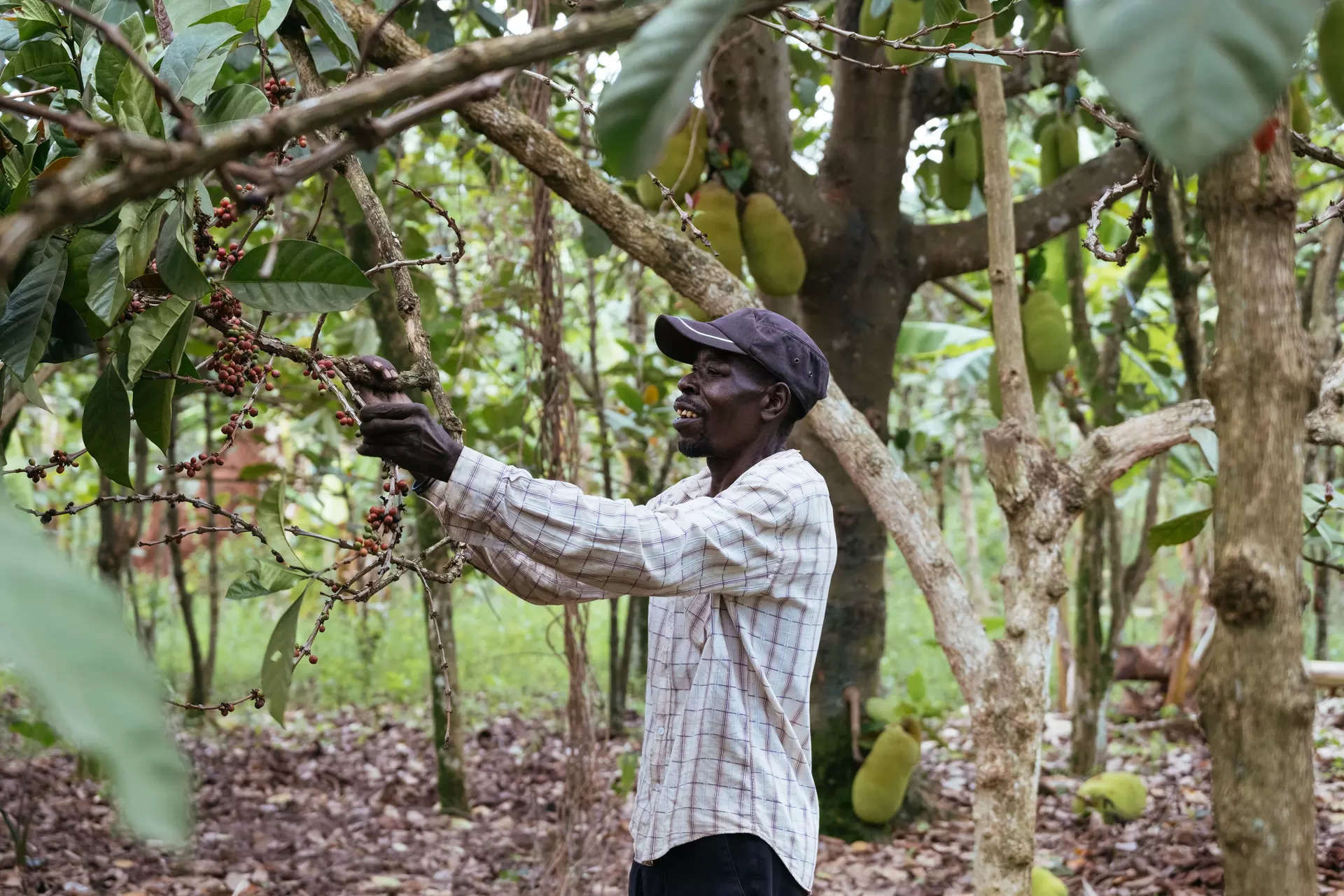Now the good news. Farmers in one of Africa’s biggest coffee exporting countries are growing a whole other species that better withstands the heat, drought and disease supersized by global warming.
For years, they’ve just been mixing it into bags of low-priced robusta. This year, they’re trying to sell it to the world under its own true name: Liberica excelsa.
“Even if there’s too much heat, it does fine,” said Golooba John, a coffee farmer near the town of Zirobwe in central Uganda. For the past several years, as his robusta trees have succumbed to pests and disease, he has replaced them with Liberica trees. On his 6 acres John now has just 50 robustas, and 1,000 Libericas.
He drinks it, too. He says it’s more aromatic than robusta, “more tasteful.”
Catherine Kiwuka, a coffee specialist at the National Agricultural Research Organization, called Liberica excelsa “a neglected coffee species.” She is part of an experiment to introduce it to the world.
If it works, it could hold important lessons for coffee farmers elsewhere, demonstrating the importance of wild coffee varieties in a warming world. Liberica excelsa is native to tropical Central Africa. It was cultivated for a little while in the late 19th century before petering out. Then came the ravages of climate change. Growers resurrected Liberica once more.“With climate change we ought to think about other species that can sustain this industry, globally,” Kiwuka said.
At the moment, the goal is to grow high-quality Liberica excelsa for export.
 NYT News Service
NYT News ServiceDeogratius Ocheng picks coffee cherries from his Liberica trees in the village of Nambi, Uganda.
Volcafe, a global coffee trading company, is hoping to ship up to 3 tons this year to specialty roasters abroad, including in Britain and the United States.
While Arabica and robusta are the two widely cultivated species of coffee, more than 100 species grow in the wild. One Liberica variety has been farmed in Southeast Asia for a century.
Another variety is Liberica excelsa, the one that is native to the lowlands of Uganda. Compared with robusta, which is also native to Uganda and the dominant coffee species grown in the region, Liberica takes longer to mature and produce fruit.
Libericas tower over robustas. Each tree can grow to a height of 8 meters (about 26 feet), so farmers need to hoist themselves up on bamboo ladders to harvest them. Or else they need to prune the trees so their branches grow wide and not up.
Around 200 farmers have been growing Liberica in small pockets, selling it to local traders together with their robusta harvest, and getting robusta prices. Kiwuka said she felt as if the farmers “were cheated.”
Liberica has a stronger aroma and is a higher quality coffee, she said; farmers should have been getting higher prices.
In 2016, she invited Aaron Davis, a coffee scientist from the Royal Botanical Gardens in Kew, England, to Zirobwe. He was skeptical at first. He had tasted Liberica elsewhere and found it to be like “vegetable soup,” he said.
But then, the next day, he ground the beans from Zirobwe in his hotel room. Yes, a coffee researcher always packs a portable grinder when traveling.
“Actually, this is not bad,” he recalled thinking. It had potential.
Davis is no stranger to the risks facing coffee. His research has found that climate change and deforestation are putting more than half the world’s wild coffee species at risk of extinction.
Kiwuka and Davis teamed up. They would encourage farmers to improve the harvesting and drying of their Liberica crop. Instead of tossing them in with the robusta beans, they would sell the Libericas separately. If they met certain standards, they would get a higher price.
“In a warming world, and in an era beset with supply chain disruption, Liberica coffee could reemerge as a major crop plant,” they wrote in Nature, the scientific journal, in December.
It is already a major crop in the orchards of Deogratius Ocheng.
When the rains are paltry, as they were last year, his 2 acres of robusta suffered. The leaves wilted. The cherries didn’t form properly. The same problems afflicted much of Uganda, where robusta is the dominant species.
Exports are expected to be lower this year, compared with last year, according to the Uganda Coffee Development Authority. Drought and pests are to blame. Had he relied on robusta alone, Ocheng said, “I would have been in extreme poverty.”
Thankfully, he had another 2 acres of Liberica.
How does Liberica excelsa taste when it’s dried, hulled and roasted? Davis called it “smooth” and “easy drinking.” It is heavy in aroma, lower in caffeine than robusta.
“It’s the Beaujolais Nouveau,” he said. “It’s very soft.”









